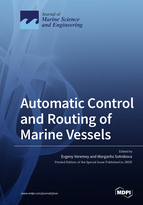Automatic Control and Routing of Marine Vessels
A special issue of Journal of Marine Science and Engineering (ISSN 2077-1312). This special issue belongs to the section "Ocean Engineering".
Deadline for manuscript submissions: closed (1 January 2022) | Viewed by 31249
Special Issue Editors
Interests: marine science and applications; marine vessels; control theory and optimization; marine control systems; autopilots; dynamic positioning systems; marine ship routing
Special Issue Information
Dear Colleagues,
Due to the intensive development of the global economy, many problems are constantly emerging connected with the safety of ships’ motion in the context of increasing marine traffic. These problems seem to be especially significant for the further development of marine transportation services, with the need to considerably increase their efficiency and reliability. One of the commonly used approaches to ensuring safety and efficiency is the wide implementation of various automated systems for guidance and control, including popular systems such as marine autopilots, dynamic positioning systems, speed control systems, automatic routing installations, etc.
This Special Issue is intended to focus on various problems related to the analysis, design, modelling, and operation of the aforementioned systems. It is proposed to place optimization approaches in the spotlight, considering that, for the most part, optimality is not the end in itself in practice. It is assumed that the optimization approach should be treated as an effective and convenient instrument to achieve desirable features of the system to be considered. This can be explained by the universality, flexibility, and convenience of modern optimization methods with respect to relevant practical implementations of control theory for marine applications.
Prof. Dr. Evgeny Veremey
Prof. Dr. Margarita Sotnikova
Guest Editors
Manuscript Submission Information
Manuscripts should be submitted online at www.mdpi.com by registering and logging in to this website. Once you are registered, click here to go to the submission form. Manuscripts can be submitted until the deadline. All submissions that pass pre-check are peer-reviewed. Accepted papers will be published continuously in the journal (as soon as accepted) and will be listed together on the special issue website. Research articles, review articles as well as short communications are invited. For planned papers, a title and short abstract (about 100 words) can be sent to the Editorial Office for announcement on this website.
Submitted manuscripts should not have been published previously, nor be under consideration for publication elsewhere (except conference proceedings papers). All manuscripts are thoroughly refereed through a single-blind peer-review process. A guide for authors and other relevant information for submission of manuscripts is available on the Instructions for Authors page. Journal of Marine Science and Engineering is an international peer-reviewed open access monthly journal published by MDPI.
Please visit the Instructions for Authors page before submitting a manuscript. The Article Processing Charge (APC) for publication in this open access journal is 2600 CHF (Swiss Francs). Submitted papers should be well formatted and use good English. Authors may use MDPI's English editing service prior to publication or during author revisions.
Keywords
- automatic control
- optimization
- control systems
- performance
- stability
- ship routing
- marine vehicles







